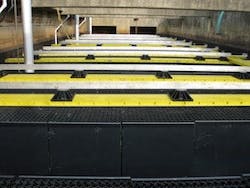Feeling the Squeeze
When the Coldwater Board of Public Utilities in Coldwater, Mich., abruptly received new ammonia permit limits in August 2007, it hired consultants Fishbeck, Thompson, Carr & Huber, Inc. (FTC&H) to guide it to a solution. With a full measure of influent waste variety—residential, commercial, industrial and septage—and a new seasonal permit limit of 2 mg/L, Coldwater needed a budget-friendly solution to consistently perform through peak flows and industrial shock loading. FTC&H immediately eliminated the possibility of constructing additional tanks due to high groundwater levels at the site. Additionally, the consultants found that adding a fourth trickling filter would far exceed cost expectations. Feeling the pressure because of Coldwater’s need to remain within its existing footprint, the engineers began to focus on an alternative solution—the IFAS process.
Small space, big impact
Decades of IFAS system applications has shown that combining submerged fixed-film media with the conventional activated sludge process promised numerous advantages with minimal limitations. A careful process evaluation showed that improving the current trickling filters’ low BOD removal rates through the installation of additional trickling filters would require a larger aeration basin to increase MCRT and the inventory of nitrifiers, as well as additional downstream clarifiers to handle the increased loading accompanied by increased BOD removal.
At this point, it became clear that an IFAS system would provide significant benefits and would allow Coldwater to achieve consistent results without increasing organic loads on the existing clarifiers.
IFAS system applications integrate the use of fixed-film media within an activated sludge process to increase the surface area upon which nitrifiers can grow and perform. By maximizing the surface area for biofilm growth without impacting the footprint, media additions to aeration tanks yield increase productivity for nitrification.
While evaluating media suppliers, FTC&H learned that consideration also needed to be given to the type of aeration system used. With ever-increasing awareness of energy consumption and associated costs throughout the industry, careful discernment should be given to the aeration system, which consumes 40 to 70% of the energy in activated sludge plants. During the technology review, the engineers learned that Brentwood’s AccuFAS system provides compelling and compatible performance results by utilizing fine bubble diffusers. Confident in the demonstrated efficiency, competitive capital and operational costs, as well as the peace of mind that the fixed media would not wash out in hydraulic surge events, the customer selected Brentwood’s AccuFAS.
The solution
When installation began in March 2010, Coldwater’s two parallel aeration tanks required retrofitted materials—a Brentwood-engineered diffuser system, supports, anchors and structured-sheet media, all of which were installed within a matter of days. The installation reached completion as the plant began to experience shock loads, reporting excess ammonia concentrations of 110 mg/L to the plant and 88mg/L to IFAS from an upstream industrial plant. Despite this loading and a briefly exceeded technology performance limit, the effluent data recorded after the AccuFAS installation showed improved effluent concentrations from the previous year, consistent nitrification improvement during the winter months and the ability to meet Coldwater’s stringent seasonal limits.
Although IFAS system solutions have existed for decades, media technology continues to evolve. By demonstrating compatibility with various activated sludge processes, IFAS systems create the opportunity to work within existing footprints, leveraging the additional surface area provided by the media to create an environment that increases sludge age and the inventory of nitrifiers. In comparative evaluations against other IFAS application media, Brentwood continues to illustrate that the AccuFAS system maximizes value to the customer by consistently achieving desired nitrification performance through energy-efficient treatment.
